Cooking a brisket correctly takes patience and skill but can be done with the right techniques. One of the most important factors in achieving the perfect brisket is controlling the brisket stall temp. This temperature stall is a natural phenomenon that occurs when cooking a large piece of meat, such as brisket, and understanding it is key to getting the best results from your dish.
This article will explain what a brisket stall temp is, how to identify it during cooking, and how to use it to get great results every time. So whether you’re an experienced cook or just starting, understanding the importance of managing your brisket stall temp will help you serve delicious and succulent briskets every time.
What Is A Brisket Stall?
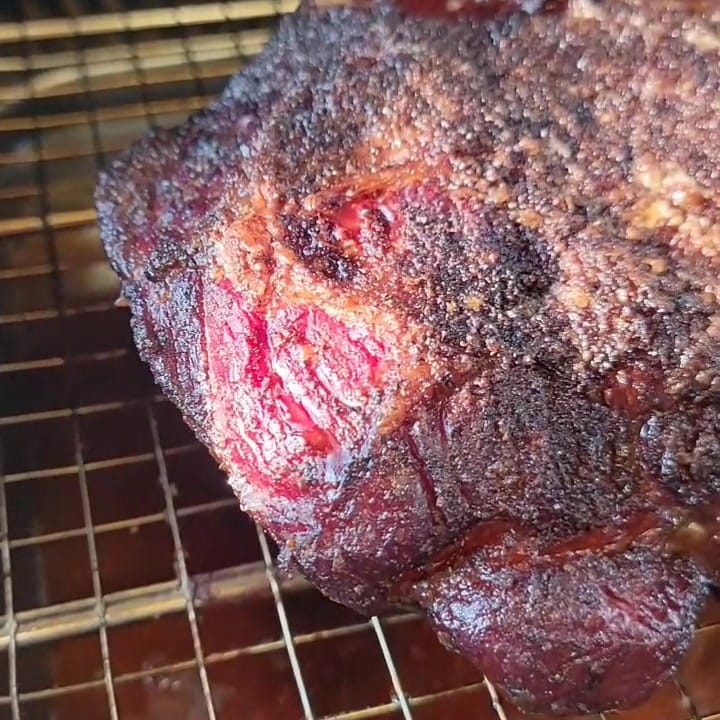
As someone who has cooked their fair share of briskets, I can confidently say that experiencing a brisket stall is a rite of passage for any pitmaster. But what exactly is a brisket stall? Well, let me break it down for you in a matter-of-fact way.
First off, let’s start with the basics. A brisket is a cut of beef from a cow’s lower chest. It’s a tough and fatty cut but becomes tender and delicious when simmered. The key to cooking a great brisket is to maintain a consistent temperature for a long period of time.
Now, onto the brisket stall. When you’re cooking a brisket, you’ll notice that the temperature of your meat will rise steadily for the first few hours. However, at some point, usually around 150-160°F, the temperature will plateau and stay at that temperature for hours. This can frustrate any pitmaster, especially if you’re on a tight schedule.
However, don’t panic! The brisket stall is completely normal, and, in fact, it’s a sign that your brisket is cooking correctly. The stall happens because of something called evaporative cooling. As the brisket cooks, moisture escapes from the meat and evaporates. This evaporation cools the brisket’s surface, slowing the cooking process.
In conclusion, the brisket stall is a natural part of cooking a brisket and shouldn’t cause any concern. Just be patient and let the brisket do its thing. And remember, the longer and slower you cook your brisket, the better it will taste.
Why Do Briskets Stall?
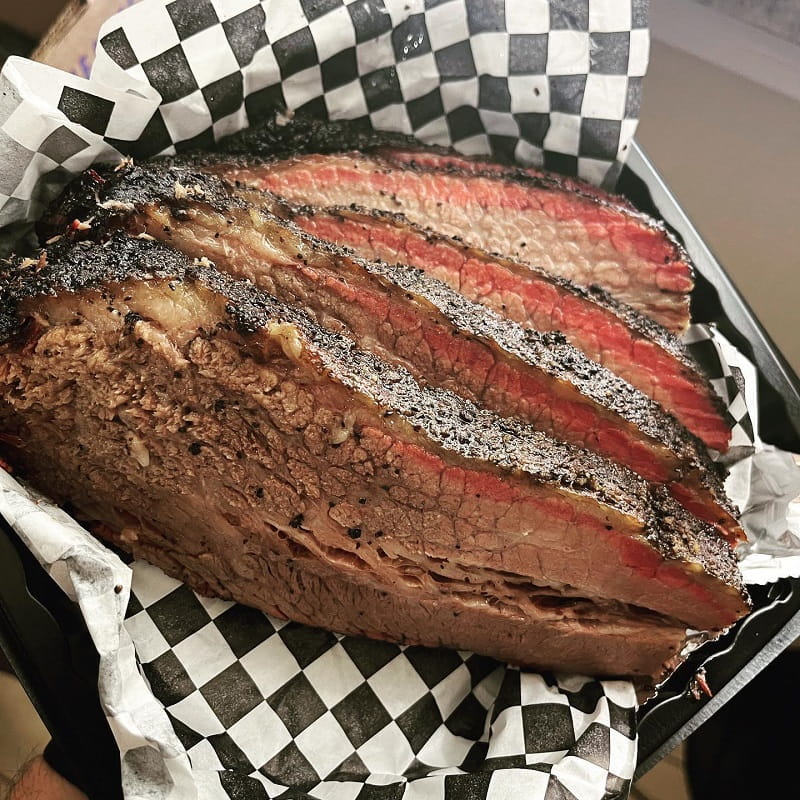
The brisket stall is a common occurrence in the world of smoking meat that occurs when the internal temperature of the brisket hits 150 to 160 degrees Fahrenheit. This results in the cooking process slowing down or even stopping completely due to evaporative cooling. As the meat temperature rises, the evaporation rate increases accordingly until it reaches a point where the cooling effect of the meat is greater than the heat energy inside the smoker. This is the point where the brisket stalls or stops cooking.
Despite several theories floating around about the cause of the stall, the most likely culprit is evaporative cooling, according to experiments conducted by Amazing Ribs and Genuine Ideas. Common misconceptions, such as latent heat lipid phase transition and protein denaturation, have been debunked as responsible for the stall.
Understanding the science behind the brisket stall and implementing the correct techniques can help pitmasters overcome it and achieve perfectly smoked brisket.
What Temperature Does Brisket Stall?
Typically, the brisket stall occurs between temperatures of 150°F to 170°F, but it can happen before or after that range. The stall is caused by porous bed-free expansion cooling, similar to evaporative cooling. As the meat sweats, moisture evaporates, and the cooling effect balance out the heat input, it causes the temperature to stall or plateau until all the surface moisture is gone.
Many techniques can be used to overcome the brisket stall, such as tightly wrapping the meat in aluminum foil, butcher paper, or a combination of both. Increasing the smoker temperature from 225°F to 250-275°F or even 300°F can also help reduce stall chances. However, regardless of the method used, it’s crucial to ensure the thickest part of the meat reaches at least 195°F (200°F is even better), using a meat thermometer to avoid undercooked meat.
Read more:
Is It Possible For Brisket To Stall More Than Once?
Briskets can stall more than once during the cooking process, though uncommon. The stall occurs when a large piece of meat, such as brisket, is cooked on low, and the temperature inside the meat stops rising. This is caused by the meat’s juices evaporating, which combines with the smoker’s temperature and causes the temperature of the meat to flatline. The stall can last for hours, considered an important part of the smoking process, but frustrating for those with guests to feed.
Brisket usually stalls between 150℉ and 170℉, but it can stall a second time at varying temperatures, such as around 175℉, 180℉, 190℉, and even up to 200℉. The exact temperature at which a stall occurs depends on many factors, including the size, moisture, marbling, and grade of the meat.
How to Beat a Brisket Stall?
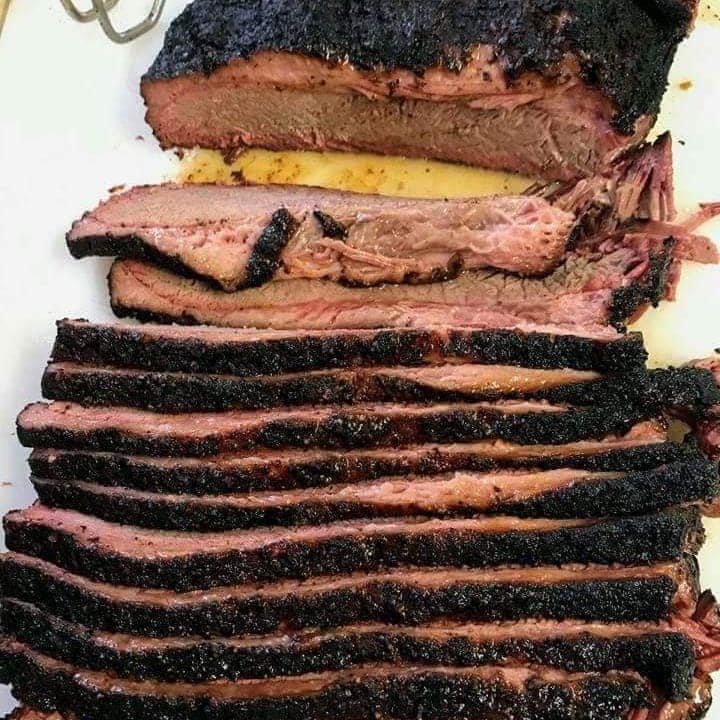
I’ve learned a few tricks to beat the brisket stall and ensure that your meat always comes out juicy and delicious.
- Understand what causes the brisket stall: The brisket stall is caused by evaporative cooling, which occurs when the rising temperature of your smoker evaporates the moisture in the meat. This cooling balances out the heat produced by your smoker’s fuel, causing the temperature of the meat to plateau, usually at around 155-165°F.
- Don’t fall for the common myths about the brisket stall: There are a number of misconceptions about the stall that experiments have debunked. These include believing the stall is caused by latent heat lipid phase transition or protein denaturation.
- Know when the stall occurs: The stall usually occurs after two to three hours of cooking when the internal temperature of the meat hits around 150°F.
- Wait to wrap further into the stall: Many people make the mistake of wrapping the meat at the start of the stall, but it’s actually important to wait until further into the stall to ensure maximum bark formation.
- Consider wrapping with aluminum foil or butcher paper: Wrapping the brisket with either aluminum foil or butcher paper can help prevent evaporative cooling and speed up the cooking process. Aluminum foil is an impermeable barrier that effectively prevents evaporative cooling from occurring but can produce soft, mushy bark. Butcher paper is a porous material that readily absorbs fat and water, resulting in a firm, crunchy bark.
- Increase the smoker temperature: Increasing the smoker temperature from 225 to 250-275°F or even 300°F can help reduce stall chances. Some smokers, like pellet cookers and electric smokers, are less likely to experience a brisket stall.
- Use the Texas Crutch: The Texas Crutch involves tightly wrapping the brisket in aluminum foil. This can speed up the cooking process and produce tender, juicy meat but can also produce soft, mushy bark.
- Don’t introduce unnecessary liquids: Some people introduce liquids like beef stock to enhance the flavor of the brisket further, but this isn’t necessary and can make the meat too wet.
- Practice patience: The brisket stall can last up to six hours, so it’s essential to be patient and wait for the temperature to rise again. Rushing the process can result in tough, dry meat.
- Experiment and find what works best for you: Ultimately, trial and error is the best way to beat the brisket stall. Try different wrapping methods, smoker temperatures, and cooking times until you find the process that produces the perfect brisket for you.
What Do I Do if My Brisket Stalls?
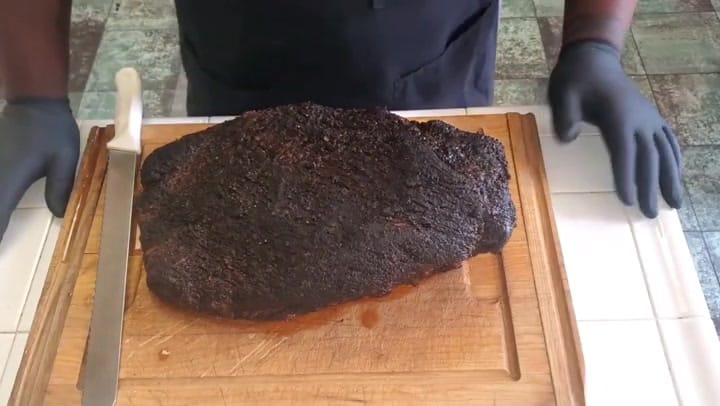
This happens when the moisture in and around the brisket evaporates as the meat temperature rises, causing the cooling effect of the meat to outweigh the heat energy from the smoker. One can either wait it out or power through to beat the stall by wrapping the brisket or increasing the smoker’s heat. It is essential to remain patient and monitor the brisket’s internal temperature for proper cooking to ensure it reaches the desired level of 195 to 200 degrees Fahrenheit.
Brisket Stall At 125
If your brisket stalls at 125 degrees Fahrenheit, it could be an indication that your smoker’s temperature is too low. As such, consider raising the temperature to 250 or 275 degrees Fahrenheit to remove the brisket from the stall as soon as possible. Leaving the meat at 125 degrees Fahrenheit for too long could lead to bacterial growth and ruin your barbecue.
Monitor the brisket’s temperature closely, and if it does not start to rise within an hour, pull it from the smoker and wrap it in a double layer of foil. Put it in a 300-degree Fahrenheit oven until the internal temperature reaches at least 140 degrees Fahrenheit. You can then return it to the smoker or continue cooking it in the oven until it is fully cooked. You could have hit the stall early if the thermometer had stayed steady at 140 degrees Fahrenheit.
Brisket Stall At 140
When a brisket stalls at 140 degrees, there are a few possible reasons and solutions to overcome it.
- Firstly, it could be because the meat is taking longer to cook than anticipated due to its size. In this case, it is important to constantly monitor the brisket’s internal temperature with an instant-read thermometer.
- Another reason for the stall could be the meat quality or the inconsistency of the smoker’s temperature, which can result in an inaccurate temperature readout. In this instance, adjusting the smoker’s temperature and adding more wood chips to produce more smoke is recommended.
- Additionally, if basting or spritzing the brisket has caused the moisture to evaporate and create a cooling effect, resulting in a stall, it is advised to reduce these activities. If the stall persists, the brisket can be wrapped in foil and placed in a 300-degree oven until its internal temperature reaches at least 140 degrees. Afterward, it can be returned to the smoker or oven to continue cooking until finished.
Utilizing these solutions can effectively manage a stalled brisket at 140 degrees.
Brisket Stall At 145
If a brisket stalls at 145 degrees Fahrenheit, there are a few things to consider. The most likely reason for the stall is due to evaporative cooling, where the moisture from the brisket evaporates and cools the meat, causing the temperature to drop. Adjusting the smoker’s temperature or increasing the smoke can help combat this.
Another possibility is if the brisket is large, it may take longer to cook properly. It’s essential to monitor the brisket’s internal temperature using an instant-read thermometer frequently. If the temperature stalls for an extended period, wrapping the brisket in aluminum foil and placing it in a 300-degree oven until the internal temperature reaches at least 140 degrees is recommended. This action helps speed up the cooking process and ensures the meat is not left in the danger zone for too long, which can be a breeding ground for bacteria.
Brisket Stall At 155
If your brisket stalls at 155 degrees Fahrenheit, there are a few tips to follow to help it continue cooking. One important factor to consider is the heat source. It might help to add more wood chips or charcoal to maintain a consistent temperature. Additionally, it’s essential to avoid opening the smoker as frequently, as this could add to the stall.
Another factor to keep in mind is the size of the cut of meat. A larger brisket will take longer to cook than a smaller one, which could lead to a longer stall period. Finally, it’s important to monitor the brisket’s internal temperature with an instant-read thermometer frequently.
Brisket Stall At 170
If the brisket stalls at 170 degrees Fahrenheit, it’s important to understand the underlying cause and how to handle it. The stall happens when the moisture on the surface of the brisket evaporates, causing the meat to cool down as a result.
The best way to combat this is to monitor the brisket’s internal temperature with an instant-read thermometer and ensure plenty of smoke goes into the cooker. If the smoker’s temperature has dropped too low, consider raising the temperature to 250 or 275 degrees Fahrenheit to pull the brisket out of the stall.
Keeping a close eye on the brisket temperature is crucial, and if it doesn’t start to rise within an hour, pull the meat from the smoker and wrap it in a double layer of foil. Put it in a 300-degree oven until the internal temperature reaches at least 140 degrees Fahrenheit. At this point, you can either return it to the smoker or keep cooking it in the oven until it’s finished.
Brisket Stall At 175
If a brisket stalls at 175 degrees Fahrenheit, there are a few possible causes and solutions to consider.
- One reason for a stall could be basting or spritzing the brisket, which increases the rate of moisture evaporation and causes more cooling. If this is the case, refrain from basting or spritzing and let the meat cook without interruption.
- Another reason could be inaccurate temperature readouts or insufficient heat from the smoker. If the thermometer is unreliable, use an instant-read thermometer to check the internal temperature of the meat and adjust the smoker’s temperature accordingly.
- Finally, if the stall persists for too long, wrap the brisket in a double layer f foil and cook it in a 300-degree oven until the internal temperature reaches at least 140 degrees Fahrenheit.
Remember, a brisket can stall multiple times, so monitor the temperature closely and make necessary adjustments to avoid prolonged stalling.
Brisket Stall At 180
A few things can be done if a brisket stalls at 180 degrees Fahrenheit. One solution to this issue is to wrap the meat in aluminum foil or butcher paper to prevent evaporative cooling from occurring.
Another solution is to increase the smoker temperature from 225 to 250-275 degrees Fahrenheit or even 300 degrees Fahrenheit to reduce stall chances. However, it’s important to monitor the temperature of the meat closely, and if it doesn’t start to rise within the hour, pull the meat from the smoker and wrap it in a double layer of foil. Put the wrapped meat in a 300-degree oven until the internal temperature reaches at least 140 degrees Fahrenheit. At this point, the meat can be returned to the smoker or continue cooking in the oven until it’s finished. Waiting too long may cause the meat to be a breeding ground for bacteria, ruining the barbecue.
Finally, it’s essential to remember that the stall could happen more than once during the cooking process, especially if the cooking environment changes drastically during the smoke.
Brisket Stall At 190
If a brisket stalls at an internal temperature of 190°F, there are recommended steps to prevent it from becoming a tough cut of meat. First, remove the brisket from the smoker and stop the cooking process. The ideal internal temperature for brisket before it is ready to eat is 195°F, so during the resting process, there is plenty of time for the temperature to rise by approximately 10°F. Wrap the brisket in aluminum foil or butcher paper while keeping it flat, and continue to use a meat thermometer to ensure it surpasses the desired 195°F internal temp.
Problems that could cause an unexpected brisket stall are inaccurate temperature readouts, insufficient heat, and the quality of the meat. Spritzing or basting the brisket can also cause it to stall a second time as the moisture has a cooling effect. Different methods can address the stall at various stages of the cooking process, such as increasing the smoker’s temperature or wrapping the brisket in a double layer of foil and cooking it in the oven.
How Long Does the Stall Last on a Brisket?
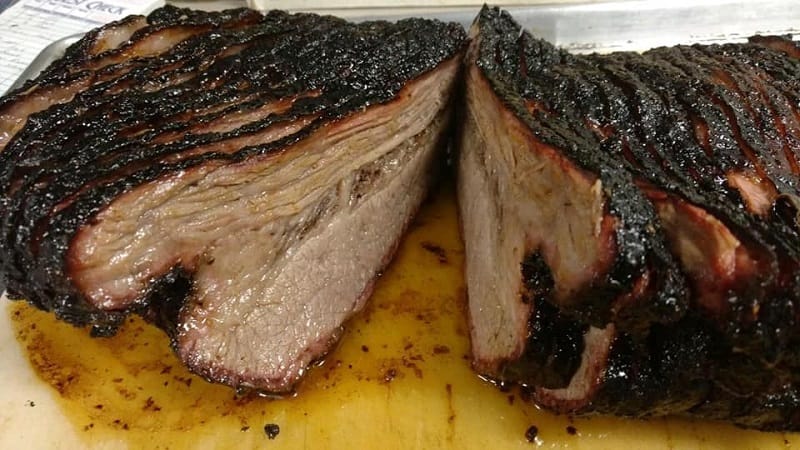
A wrapped brisket cooked at 250°F will usually stall for around 2 hours, while an unwrapped brisket or a brisket cooked in the 225°F range will stall longer. Sometimes the temperature may drop to the point where the brisket temperature goes backward, and the stall can last 5 or 6 hours if no action is taken.
It is hard to determine exactly when and for how long a stall will occur, as many variables, such as the type of smoker, the cooking temperature, and the size of the brisket, can affect it. Strategies for dealing with the stall include planning, building momentum before the stall, cooking the brisket overnight, cooking at high temperatures, or starting low and finishing high.
It is important to monitor the brisket’s internal temperature and adjust as needed to ensure successful cook. While the stall can increase the cooking time of a brisket, understanding the science behind it can help pitmasters overcome it and still achieve tender, juicy meat.
Should You Wrap Your Brisket Before Or After Stall?
When smoking brisket, whether to wrap it before or after the stall arises. Wrapping before the stall can help prevent the stalling process from even starting, resulting in less monitoring of the meat probe and softer bark or none at all. However, it can also lead to mushy brisket and less moisture retained in the cuts of beef.
On the other hand, wrapping after a stall helps to lock in the brisket’s natural juices, keeping the meat moist and tender. The best time to wrap the brisket is towards the last 3 hours of the cooking process, with the internal temperature of the meat being monitored frequently.
Two main materials utilized for wrapping briskets are aluminum foil and butcher paper. While aluminum foil is common and easy to use, it can result in a softer bark, which may not be preferred. Butcher paper is generally the preferred wrap of most Texas barbecue cooks, as it enhances the meat’s flavor but can take longer.
Ultimately, whether to wrap brisket before or after a stall is subjective and depends on individual preferences.
How Do Pitmasters Control And Monitor Temperatures In Their Smokers?
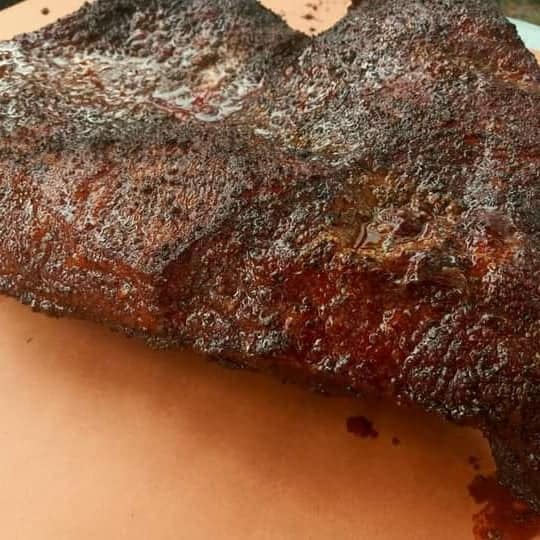
As a pitmaster, it’s essential to know how to control and monitor temperatures in your smoker. There’s nothing more frustrating than putting hours of work into smoking meat, only to find out that your temperatures were too high or too low and ruined your hard work.
One of the most essential tools a pitmaster uses for temperature control is airflow. Oxygen is needed to keep the fire burning, and airflow is essential for a consistent burn and heat output. By controlling the airflow, we can control the temperature.
Many pitmasters use a digital thermometer with a probe to monitor the temperature. These thermometers have a wireless receiver that can be carried with you, allowing you to monitor the temperature without being physically near the smoker. This is especially useful for overnight smokes when you need to get some sleep but still need to keep an eye on the temperature.
Another tool that some pitmasters use is a temperature controller. These devices can be attached to the smoker and regulate the temperature by controlling the airflow to the fire. They use a thermostat to monitor the temperature and adjust the airflow accordingly. This can be a great tool for beginners or those who need to step away from the smoker for some time.
Different types of wood also burn at different temperatures, so choosing the right wood is important for temperature control. For example, oak burns hotter and longer than fruitwood like apple or cherry. Pitmasters often mix wood to achieve the desired flavor and temperature.
Lastly, the size and shape of the smoker can affect temperature control. A larger smoker will require more fuel and airflow to maintain temperature, while a smaller smoker will require less. The shape of the smoker can also affect airflow and temperature distribution.
What Kinds Of Meat Thermometers Are Recommended For Smoking Brisket?
One of the most crucial tools for smoking brisket is a meat thermometer. But with so many options out there, it can be overwhelming to choose the right kind. Here, I will share my experience and recommend the kinds of meat thermometers best suited for smoking brisket.
- First on the list is the Instant-read thermometer. As the name suggests, this thermometer gives you an instant reading of the internal temperature of your brisket. It is perfect for checking the temperature at different times throughout the smoking process, allowing you to adjust the temperature and cooking time accordingly. I highly recommend having this thermometer on hand when smoking a brisket.
- Next up is the Leave-in thermometer. This type of thermometer is designed to remain in the meat throughout the entire smoking process. It is beneficial when smoking larger cuts of brisket, as it allows you to monitor the temperature without opening the smoker and losing heat. Leave-in thermometers also come with alarms that sound when the desired temperature is reached, making them very convenient.
- Wireless thermometers are another great option. These come with a transmitter and receiver that communicate wirelessly, allowing you to monitor the temperature of your brisket from a distance. This is especially useful when smoking brisket overnight or when you need to step away from the smoker for a while. You can monitor your home or office temperature with a wireless thermometer.
- Finally, there are the probe thermometers. These are similar to leave-in thermometers in that they remain in the meat throughout the smoking process. However, probe thermometers come with multiple probes, allowing you to monitor the temperature in different parts of the meat. This is especially useful when smoking larger cuts of brisket, as it ensures that the entire cut is cooked evenly.
How Can Pitmasters Maintain A Consistent Temperature Throughout The Smoking Process?
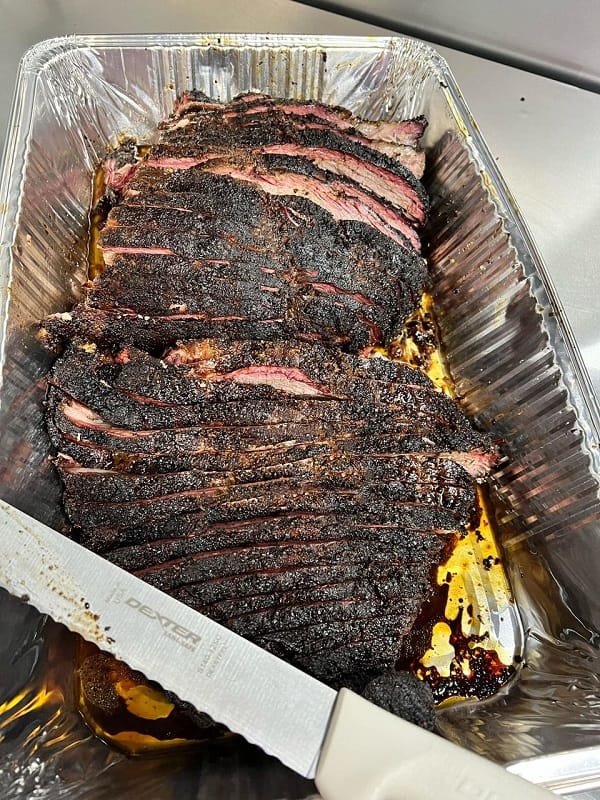
Pitmasters know maintaining a consistent temperature throughout smoking is important to achieving perfect results.
To do this, experts recommend using proper airflow when starting the fire in the firebox. It’s important to leave the ashtray slightly open, the top two firebox vents closed, and the bottom firebox vent completely open. The flue damper should also be completely open to allow the fire to draw in oxygen from the firebox and vent it out through the flue.
Start with smaller pieces of wood when lighting the fire, and add bigger pieces later in the cook. The best size of timber to use in a smoker is spits that are about 4 – 7cm thick and around 30cm long. Once the fire is going, shut the door on the firebox, leave the bottom firebox vent open, and close the chimney a quarter of the way. The ideal temperature for slow-cooking brisket, pork, lamb, and chicken is around 225-250°F/107-120°C.
During the cook, adjust the flue damper to increase or decrease the airflow through the smoker. If the smoker is getting too hot, close the damper further, and if it is cooling down too much, open the damper up and consider putting more wood in the firebox. Investing in a quality thermometer and temperature control kit also helps maintain a consistent temperature throughout the smoking process.
In summary, maintaining a steady cooking temperature in an offset smoker requires proper airflow, using the correct size of timber, and using a thermometer and temperature control kit.
Are There Any Tips Or Tricks To Help Keep The Internal Temperature Of My Brisket From Fluctuating During Cooking?
One of the biggest challenges I face when cooking brisket is keeping the internal temperature from fluctuating. It’s a delicate process that requires patience, attention, and a few tricks up your sleeve.
The first tip I can offer is to use a good quality smoker or grill that can maintain a consistent temperature. A smoker with a built-in thermostat or digital controller can be a real lifesaver, as it allows you to set the desired temperature and keep it steady throughout the cooking process.
Another important factor to consider is the wood or charcoal you use. Different fuel types will burn at different rates and temperatures, so choosing one that will provide a steady and consistent heat source is important. I prefer to use a combination of hardwood charcoal and real wood chunks for added flavor.
When it comes to cooking, it’s important to resist the temptation to open the lid or door too often. Every time you do, you’re allowing heat to escape, making it harder to maintain a consistent temperature. I recommend using a wireless digital thermometer to monitor the internal temperature of the meat without having to open the smoker or grill.
Another trick I’ve learned over the years is to wrap the brisket in foil or butcher paper once it reaches a certain internal temperature. This helps to hold in moisture and prevent the meat from drying out while also helping to maintain a steady temperature.
Finally, it’s important to give yourself plenty of time and not rush the cooking process. Brisket is a tough cut of meat that requires a long, slow cooking time to break down the collagen and become tender. I typically plan for at least 12 hours of cooking time, and sometimes even longer, depending on the size of the brisket.
FAQs
Can a Brisket Stall Too Long?
The stall is caused by a process called evaporative cooling, where the brisket stops cooking due to the cooling effect of the moisture on the meat’s surface. While the stall can increase the cooking time of the brisket, it is not harmful to the meat. However, the good news is that the brisket cannot stall for too long. It may last several hours, but the cooking process will eventually begin again, and the brisket will reach its target temperature. The key is to be patient and trust the process, as rushing or interfering with the cooking process may result in a dry or tough brisket.
When Smoking Brisket, What Is The Ideal Temperature Range For Maintaining Heat Over Several Hours?
The optimal temperature range for smoking brisket over several hours is between 210 and 230 degrees Fahrenheit. This temperature range ensures that the fat and connective tissues break down and cook evenly, resulting in a tender and flavorful brisket.
To maintain this temperature range, it is important to use an oven thermometer or digital thermometer to monitor the smoker and brisket temperature throughout the smoking process. Adjusting the temperature as needed will keep the brisket in the ideal range. Once the internal temperature of the meat reaches between 195 and 205 degrees Fahrenheit, it is time to let the brisket rest so the juices can redistribute within the meat.
What Makes “Low And Slow” Cooking An Ideal Method For Smoking Brisket?
Low and slow cooking is ideal for smoking brisket for various reasons.
- Firstly, it involves cooking the beef brisket at a low temperature between 200 and 250°F in a smoker for an extended period of time, typically 12-14 hours. The low temperature ensures that the meat is slowly cooked, allowing the connective tissue and collagen in the meat to break down gradually, making it tender and flavorful.
- Secondly, smoking the brisket enhances the flavor by infusing it with smoky aromas, achieved by using wood chips such as hickory, oak, or mesquite in the smoker. This method of cooking gives the brisket its signature smoky flavor and aroma.
- Thirdly, low and slow cooking allows for better penetration and distribution of the seasoning and marinade throughout the meat, resulting in a well-flavored and juicy brisket.
- Lastly, low and slow cooking is preferred over other methods because it allows the cook to maintain control over the cooking process and preserve the natural moisture in the meat, ensuring that the brisket remains tender and succulent.
Overall, low and slow cooking as a method of smoking brisket is highly recommended since it produces delicious and mouth-watering meat with a unique smoky flavor.
Conclusion
In conclusion, understanding the brisket stall temp is essential for anyone who wants to smoke a perfect brisket. Knowing how to push through the stall and get your meat to the ideal temperature will ensure that you end up with a juicy, tender, and flavorful brisket that will have your guests coming back for more. So, the next time you’re smoking brisket, embrace the stall and remember that good things come to those who wait.
References:

Hey readers! Chip Holland here, and I’m a Manager of this website. My passion for writing about it only matches my passion for BBQ. Follow my blog for mouth-watering recipes, tips, and tricks for the perfect smoke, grill, and BBQ. I’m sure you won’t be disappointed!
